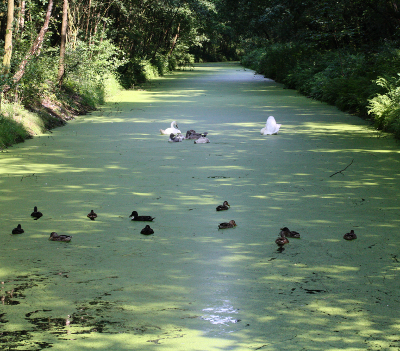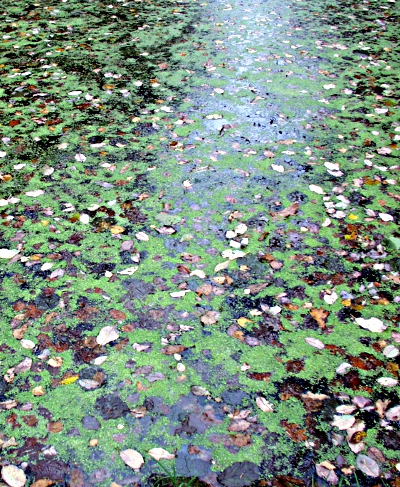Lemnoideae, duckweeds |

Ducks and swans on a watercourse covered with duckweed

Duckweed and autumnal leaves on a standing water
The duckweeds, consisting of 5 genera and 40 species, occur worldwide and colonize standing waters. The representatives of the Lemnoideae are usually greatly reduced plants. Sprout and leaves are reformed to so-called fronds – a few mm large, lenticular discs with incorporated air tissues that sometimes float freely on the water surface, sometimes even below it. The fronds in the genera Lemna, Landoltia and Spirodela form one or more roots, with which they extract nutrient salts from the water, in Wolffia and Wolffiella themselves lack these.
The multiplication takes place predominantly by budding, whereby a new one grows out of the edge of the frond, which either remains connected to the mother plant or dissolves. Depending on the species, the daughter plants are formed successively or two ones at the same time. On rare occasions duckweeds bloom, and if so, the flowers are almost invisible because of their smallness.
The flowers however reveal the belonging to the Araceae: they are greatly reduced and are surrounded by a very small, but existing spathe. The inflorescence can be interpreted as a very much reduced spadix. Mostly it consists of two male and a female flower that lack the petals.
Female flowers only consist of a single carpel which form a bottle-shaped ovary, that ends in a thin stylus with a funnel-shaped scar. Male flowers consist of only 1 or 2 stamens. After pollination by flies, mosquitoes, water striders and water spiders, small, achene-like fruits develop, which open by bursting or by dissolving of the pericarp. The up to 6 seeds sink to the ground and can even survive prolonged drought.
| Floral formula: |
| ♂ * P0 A1–2 G0 ♀ * P0 A0 G1 |
Some Lemnoideae develop in late summer to autumn, before the fronds die, smaller, containing less air tissue and more starch, differently shaped and rootless winter buds (turions), which sink to the bottom of the body of water, and spend the winter there in the mud. In spring they begin to grow and develop air tissue so that they ascend. The starch is used as an energy source for new fronds. Other species produce for the winter only smaller, starchy fronds, which remain on the surface.
Duckweeds are popular "guinea pigs" in the ecological and genetic research. They are easy to cultivate, grow very quickly and by vegetative propagation arise genetically identical individuals.
The Lemnoideae are probably those plants that can produce biomass most rapidly. Under good conditions, they can double it in 2 days. Clearly this means that a pond whose surface is covered to 25 % with duckweed, can be completely overgrown in 4 days.
Interesting notes
Lemnoideae are eaten by waterfowl, which is why they are also called "duckweed". Also grass carps does not disdain the floating plants.
Duckweed are non-toxic and edible. Eaten raw, they are, however, very tough. In some East Asian countries, Wolffia globosa is similarly prepared and consumed like spinach.